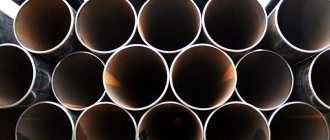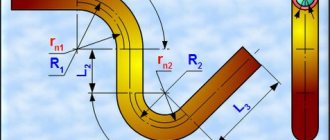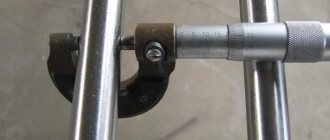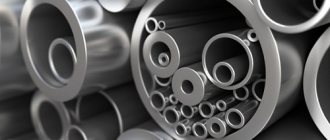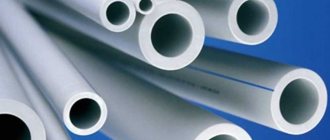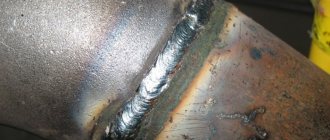- home
- What is the difference between a cold-deformed pipe and a hot-deformed one?
Seamless pipes are made without welding, so they do not have connecting seams along the entire circumference. This technology is more complex, more expensive and requires more production resources. But its advantage is obvious - the absence of weak areas in the form of joints allows the products to be used in systems with high pressure and sudden changes.
Rolled metal is produced in two ways: cold-rolled and hot-rolled. They differ in processing method and quality characteristics.
Product Features
The range of seamless cold-deformed steel pipes is quite wide. They are created with a primary focus on pipe rolling technology.
At the end of the production cycle, the finished product is run through the final strip of rolling rolls in a cooled state.
In addition to the special production methodology, the main distinguishing feature and advantage of seamless cold-formed pipe (compared to conventional pipes) is a significantly increased safety margin.
It exceeds the performance of conventional pipes by 25%. The next feature and advantage that characterizes these pipes is the highest accuracy of the declared wall size.
This allows the use of such products in the construction of high-tech pipelines and in the creation of high-precision machines and devices. Unlike conventional pipes, cold-formed pipes can be bent to the desired angle.
This makes them indispensable in the production of furniture fittings and electric lighting.
Electric-welded cold-deformed pipes can withstand fairly high and low pressures; in addition, square cold-deformed pipes, like other varieties, are widely used in:
- Communal services;
- Automotive production;
- Oil and gas field;
- Construction;
- Boiler installations.
Due to the highest quality of external and internal working surfaces and resistance to high temperatures and pressure changes, cold-formed pipes are widespread everywhere.
GOST 8734 for cold-deformed pipes takes into account all the parameters of this product and is applicable to all types of currently produced products.
A hot-deformed pipe is presented in the form of a product that has a cylindrical shape and a round diameter. The key feature of this product is the complete absence of joints (joints, seams) of any type.
The complete absence of seams and joints allows hot-deformed pipes to have a very high margin of safety against mechanical damage.
This makes it possible to pump liquids and media under high pressure. Hot-deformed pipes are produced based on popular sizes.
As a rule, the diameter of such products varies from 25 to 700 mm. In addition, the wall thickness of such pipes can reach only 5 mm, although they can withstand pressures of up to 60 bar or more, unlike conventional pipes.
GOST for seamless hot-deformed steel pipes regulates that this type of hot-rolled product can be made from steel with 10, 45 and 15ХМ markings.
Advantages and disadvantages
Let's consider the pros and cons of cold-deformed seamless bends.
The advantages of the product include:
- Higher quality of workmanship in terms of dimensional accuracy and geometry of products in comparison with hot-rolled products.
- Greater strength, allowing the use of pipes in complex and critical systems.
- The ability to process products with chrome plating and galvanizing, which improves their anti-corrosion properties.
The disadvantage is the high price compared to hot-rolled products.
Types of products
Before you buy a seamless hot-deformed pipe, you should keep in mind that they are divided into several subtypes:
- Particularly thin-walled products;
- Thin-walled products;
- Thick-walled products;
- The products are especially thick-walled.
All of the above products are ideally suited for the correct and safe transportation of various chemically aggressive liquids and are widely used in:
- Construction;
- Oil industry;
- Mechanical engineering;
- Chemical industry;
- Processing industry;
- Formation of main pipelines to ensure efficient heat supply.
The significant advantages of cold-deformed and hot-deformed pipes lie in the highest strength characteristics, which entails the possibility of using these products in any climatic conditions.
Such products have the following features:
- They have a reduced coefficient of linear expansion with significant changes in temperature around them;
- Can be used to transport liquids and gases;
- Due to the peculiarities of production technology, they exhibit increased resistance to hydraulic shocks;
- Seamless, do not have any joints;
- They bend without deforming the structure at the desired angle.
The main disadvantage of cold-deformed and hot-deformed pipes is their susceptibility to corrosion processes.
High resistance to the transported flow of the working substance leads to the formation of deposits on the internal walls. Disadvantages also include the large weight of this type of fittings and fairly high cost.
In addition, the installation of highways should only be carried out by specialists using special methods.
What should you know when choosing?
Before you buy seamless cold-formed steel pipes, you should be aware that the current price of seamless cold-formed pipes may fluctuate.
When choosing, you should always pay attention to the specifics of the scope of application and the subtleties of operational characteristics.
GOST for cold-deformed seamless pipes allows them to be manufactured from high-carbon, alloy and high-alloy steel grades.
Wall thickness directly correlates with the parameters of strength and degree of resistance to mechanical damage. When choosing, keep in mind that there is a direct relationship between the outer diameter of the pipe and the wall thickness.
The price of seamless hot-deformed pipes also varies and depends on many indicators.
However, when choosing it, you should remember that this product is used in most cases at those facilities where operation requires increased strength from the product.
In addition, hot-formed pipes are divided into several categories, the specifics of each of which are appropriately directed to the specific areas of application.
- Class A – normalized mechanical properties;
- Class B – normalized chemical properties;
- Class G – standardized chemical composition and control of mechanical properties on samples;
- Class D - normalized test hydraulic pressure.
The price of seamless hot-deformed steel pipe is as follows:
- buy seamless hot-deformed steel pipes, 57 x 3.5 mm in size - you can buy from $3 to $5 per 1 meter;
- seamless hot-deformed, size 68 x 5 mm - from 4 to 6 $ per 1 meter.
The price of cold-deformed seamless steel pipe is as follows:
- price of cold-deformed steel pipe, GOST 8734-75, size 48 x 3 mm - up to $5.5 per 1 meter;
- cold-deformed steel, GOST 8733-74, size 14 x 3 mm - up to $6 per 1 meter.
Installation nuances
The technology used to connect and subsequently install products corresponds to advanced methods of joining welded products. The choice of a specific method depends on the difference in the working diameter and wall thickness.
In any case, welding the joints is performed in exactly the same way as when connecting any other pipes: the edges of the two segments are cleaned and aligned, after which they are tacked together by welding.
After this, a weld is created along the entire diameter of the product. Then the connected product cools down.
The threaded joining method is applicable to systems where the pipe walls have normal or thin thickness.
Thread cutting is done using a lathe, and the weight of the seamless hot-deformed steel pipe allows this to be done without much difficulty.
After cutting is completed, the product can be joined to the required line, which also has a thread.
Gas welding is applicable in cases of installation of thin-walled and thick-walled pipes, with a nominal wall thickness of up to 6 mm. On such products, welding edges are preliminarily formed at the ends, and chamfering is performed.
When carrying out electric welding, it is possible to install pipes of all types with different wall thicknesses, however, when connecting, one should take into account the correspondence of the diameter of the electrode, which should be thicker than the wall of the product.
Nuances of production (video)
Vazyanov Evgeniy Viktorovich
Civil Engineer
We will make an estimate or select the best offer
Hot-deformed or cold-deformed steel pipe is considered the highest quality metal pipe, which allows the product to be used in various fields of construction and so on. What is the difference between cold-formed and hot-formed pipes? Where are these types of pipes used? What nuances exist when installing this or that type of pipe? Answers to these and many other questions can be obtained by reading this article.
Pipes made of steel
Pipe selection
The most difficult issue is the choice of pipes for the manufacture of certain structures or pipeline construction. When choosing, it is recommended to consider:
- the possibility of using different types of pipes for a specific purpose;
- specifications;
- pipe sizes.
Scope of application of hot-formed pipes
Hot-deformed pipes are made from a metal ingot heated to a high temperature by rolling.
Manufacturing process of hot-formed pipes
The finished product is solid, that is, it has no welds and is distinguished by the following qualities:
- high resistance to mechanical damage, temperature changes and hydraulic shocks;
- resistance to high pressure and high temperatures;
- seismic resistance.
Where are hot-formed pipes used? Advantageous areas of application are:
- chemical industry;
- mechanical engineering;
- oil refining and oil production industries;
- heat supply.
Due to the nature of production, hot-deformed pipes are produced with a larger wall thickness, which provides additional strength to the product.
Scope of application of cold-formed pipes
Final processing of cold-deformed pipe is carried out without exposure to high temperature.
Manufacturing process of cold-formed pipes
Cold-deformed pipe has the following qualities:
- high strength. Due to the nature of the production process, the strength of cold-formed pipes is approximately 25% greater than that of other types of steel pipes;
- accuracy of the declared dimensions;
- susceptible to bending;
- the ability to withstand low and high temperatures, different pressures, water hammer, temperature changes.
The advantages of cold-formed pipes determine the area of their use. This type of steel pipes is used:
- in the manufacture of furniture fittings and individual furniture elements;
- in the manufacture of electric lighting;
- in public utilities (construction of pipelines for various purposes);
- construction of frames;
- in mechanical engineering;
- in boiler installations;
- in the oil and gas industry.
The only disadvantage of cold-deformed and hot-deformed steel pipes is the high level of susceptibility to corrosion, which is reduced due to additional chemical treatment - galvanizing.
Specifications
When using pipes, it is important to know not only the type, but also the technical characteristics of the products, which are indicated on the label:
- if the manufactured pipe has a diameter of more than 100 mm, then the marking is applied to its surface;
- if a pipe of a smaller diameter is being manufactured, then the markings must be in the accompanying documentation.
When applying markings, the following parameters are indicated:
- name of the manufacturer;
- GOST or technical conditions in accordance with which this pipe was produced;
- steel grade used for manufacturing;
- dimensions: outer and inner diameter, wall thickness;
- maximum pressure, temperature, and so on.
Technical characteristics of pipes
For the manufacture of a certain structure or pipeline, it is important that all characteristics clearly coincide (have a margin of safety) with the technical documentation of the structure.
Pipe range
How to choose pipes? In addition to technical characteristics, when constructing pipelines, it is also important to choose the correct diameter.
The range of hot-rolled steel pipes is presented in GOST 8732 78.
Produced pipes may have:
- outer diameter 20 – 550 mm;
- pipe wall thickness from 2.5 mm to 75 mm.
In this case, the length of pipes produced in accordance with GOST can be:
- unmeasured (from 4 m to 12.5 m);
- multiple unmeasured with an allowance of 5 mm.
Dimensions of hot-formed pipes
The dimensions of cold-deformed pipes are regulated by GOST 8734 75, according to which:
- the diameter of the tubes can be 5 mm – 250 mm;
- The thickness of the pipe wall is in the range of 0.3 mm - 24 mm.
The length of the pipes can be:
- measured within 4.5 – 9 m;
- unmeasured within 1.5 - 11.5 m.
Dimensions of produced cold-formed pipes
Where can I buy
It is not difficult to buy pipes - all large construction hypermarkets and large markets have a large assortment of pipe products. There are also many manufacturers, and each region has its own. You will have to select pipes visually and based on the presence of a certificate. However, even before purchasing, it is worth assessing the future structure or system - in home construction, high strength and tightness are not always required.
For a fence, enclosure, heating system or fencing, you can choose pipes of any quality; when used for a canopy or roofing, you should choose seamless products. If the structures will be loaded or responsible, be sure to request a quality certificate from the seller. But also look with your eyes to see if there is a lot of rust, if the wall thickness corresponds to the declared one, if there is a strong bend or even waviness, or even holes in the walls.
The nuances of installing different types of steel pipes
Cold-formed and hot-formed steel pipes can be connected in the following ways:
- welding method;
- threaded fittings.
When welding, a more durable and airtight seam is obtained, so this method is chosen when it is necessary to obtain a durable pipeline, for example, for gas, heat supply, and so on.
Pipe connection by welding
Welding is performed by professional craftsmen, as it requires certain equipment and work skills.
How to properly connect pipes using welding, watch the video.
The threaded method is mainly used in the construction of household pipelines, for example, when installing a water supply system in a residential area.
How to install pipes with threaded fittings? The connection is made according to the following scheme:
- the ends of the pipes are prepared for the connection: they are cleaned of dirt, rust, etc., threads are cut;
- The thread is sealed with any selected material. You can use Tangit Unilok thread, linen thread and so on;
- the fitting is connected to the prepared section of the pipe and tightened.
Connecting steel pipes with threaded fittings
Properly selected and well-installed cold-formed and hot-formed steel pipes will last more than 50 years.
The difference is in thick-walled and thin-walled pipes Advantages of seamless pipe GOST 8732. Production of seamless steel hot-deformed pipes and cold-deformed pipes
Seamless steel pipe does not have longitudinal or transverse seams; such pipes are more durable and reliable than welded pipes. The advantage of such pipes is their increased tensile strength; it is possible to manufacture pipes with thick walls. Seamless pipes are used to make machine parts, pipelines for water, gas, steam; they are used in aircraft and shipbuilding, in the chemical industry and oil production, for domestic needs, in the manufacture of metal structures and as various supports.
Seamless pipes are measured by outer diameter, for hot-formed pipes the diameter in mm is 25 - 700 mm, for cold-formed pipes the pipe diameters are 5 - 250 mm. Hot-deformed seamless steel pipes GOST 8732 are made from alloy and carbon (steel 20, steel 35, steel 45) steel. Hot-deformed seamless pipes are resistant to temperature changes. Seamless steel pipes are susceptible to corrosion, so anti-corrosion coatings are used. But hot-deformed pipes are less susceptible to it than cold-deformed ones. However, pipes obtained by hot deformation are more fragile. Also, substances are formed on the inside of a seamless pipe that reduce the internal passage of the pipe. Street heating pipes are carefully insulated to prevent energy losses from the carrier.
Seamless pipe production
Seamless hot-deformed steel pipe GOST 8732-78 is rolled in a hot state. Cold-deformed seamless steel pipe GOST 8734-75 is produced by cold rolling. During hot deformation and cold deformation , a metal rod is taken for the workpiece and heated in a furnace until the metal becomes plastic. Then this blank is sent under a press, in which the core is removed from it - this way a sleeve is obtained. For hot-deformed pipes, the sleeve is passed through rollers, pulled out while hot, shaped, the hot billet is cooled in containers with water and rolled again. Thus, a pipe with a certain diameter and wall thickness is obtained, and dimensional defects are eliminated. Then the pipe is cut to the dimensions established by GOST.
In the production of cold-formed pipes, the cooled sleeve is rolled in a cold state. To improve the quality of the pipe, it undergoes annealing - the pipe is recrystallized and cooled, rolled for the last time and cut to size. Annealing removes residual stresses, which have a destructive effect on the metal.
Maximum deviations in pipe length, outer diameter of pipes and pipe wall thickness , ovality, curvature of pipes are specified by GOST. Cracks, sunsets, and flaws are not allowed on the surface of pipes. But minor dents, risks, traces of cleaning defects, nicks are possible, if they do not take the wall thickness beyond the minus limits. By agreement with the consumer, pipes of approximate length and with a wall thickness of more than 16 mm are produced.
Pipes are distinguished between thick-walled and thin-walled, and the same wall thickness for a different pipe cannot make it thick-walled or thin-walled. Pipes are distinguished depending on the ratio of the outer diameter (Dн) to the wall thickness (s):
for a thick-walled pipe this number Dн/s ( outer diameter, wall thickness ) is 6 - 12.5 ( Pipe mm 89 * 10.0),
for a thin-walled pipe the ratio is 12.5 - 40 (Pipe 168 * 7.0). Thin-walled pipes also include pipes with a diameter of 20 mm or less, with a steel pipe wall thickness of 1.5 mm.
For extra-thin-walled Dн/s - more than 40 (Pipe 426 * 9.0), these also include pipes with a diameter of 20 mm and a wall thickness of less than 0.5 mm inclusive. For extra-thick-walled pipes this figure is less than 6 (pipe 60* pipe wall 12mm).
Thin-walled pipes significantly facilitate the design due to their low weight.
They are used in construction, design, in many industries, in the production of advertising products, refrigeration equipment and furniture, and the automotive industry.
Thick-walled pipes have increased strength and durability; when installing such pipes, leakage of toxic substances is eliminated and tightness is ensured. They are used at high pressure, for main pipelines, for drilling rigs, boiler equipment, nuclear power plants, in hydraulic and energy systems.
When using thick-walled pipes, be sure to first chamfer the edges, since the welding seam otherwise will not cover the rolled thickness and will be fragile.
Seamless pipe is a design with the highest consumer characteristics. It is often used in the industrial sector, and all thanks to its strength, reliability and resistance to external influences. It is divided into two types: cold-deformed and hot-deformed pipes.
Thick-walled hot-deformed pipes
Production process
The type of rolled steel we are considering is produced by the cold-rolled method.
First, the cylindrical billet is hot rolled in a mill, resulting in a hollow pipe billet.
After cooling, the process of cold deformation begins directly. The workpiece is either drawn to the required dimensions on a rolling mill, or pulled through a drawing ring, achieving the required conditions.
The first method is to obtain a cold-rolled pipe, the second - a cold-drawn pipe.
To improve performance characteristics, the product is thermally treated during the production process.
Materials for production
Products are made from high-quality alloys of carbon, alloy or low-alloy steel, some of its types are made from corrosion-resistant steel.
The quality of products largely depends on the raw materials used. The most popular steel is grade 20. It is a high-tech alloy that is easy to process and has good weldability.
The 09G2S grade has high strength and resistance to low temperatures. The following brands are also used: 40х, 30ХГСА, 45, 10, 35.
For use in medicine, food and chemical industries, seamless pipes are made of stainless steel. Here the 10Х17Н13М2Т brand has no competition.
Method for creating capillary materials
Capillary tubes occupy a special place among seamless pipe products. They are made of stainless steel with an outer section from 0.3 to 5 mm. GOST regulations 14162–79 establish more stringent requirements for the dimensional accuracy and surface quality of such bends.
Products are produced by drawing through a gauge of minimum diameter.
Difficult production conditions for this type of seamless product require significant costs, which is also reflected in the price of capillary tubes.
Seamless cold-formed pipes
They are produced using the same technology (rolled pipes) as hot-deformed products. Only at the very end of the work is the product put through additional rolling in a cold state. Various rolling technologies make it possible to obtain output products with different technical characteristics, which provides a wide range of possibilities for using pipes.
Cold-formed products
Main Applications:
- Utilities;
- Automobile production;
- Oil and gas area;
- Chemical industry;
- Production of various types of mechanisms;
- Construction;
- Boiler installations.
Why are cold-formed seamless pipes so widely used in the production of automobiles and various machinery? It's all about the high-quality outer and inner surfaces, as well as excellent load-bearing properties and resistance to high internal pressure.
Hot-formed products
According to GOST, a standard product can be made of steel under the grades 10, 35, 20, 45, 15ХМ. All standards that the product must comply with are determined by GOST 8734-85.
Products are divided into 4 main categories:
- Particularly thin-walled products;
- Thin-walled products;
- Thick-walled products;
- Particularly thick-walled products.
Speaking about the characteristics of cold-formed seamless pipes, one cannot fail to mention their high dimensional accuracy of shapes and walls. That is why they can be used with equal efficiency in laying pipeline systems and in the production of various devices.
Seamless hot-formed pipes
These products are ideal for transporting aggressive liquids. Widely applied in the following fields:
- Construction;
- Oil industry;
- Mechanical engineering;
- Chemical industry;
- Processing industry;
- Housing and public utilities sector (construction of main pipelines).
Extra thick wall pipes
Standards for the production of hot-deformed pipes are determined based on GOST 8732-78 and GOST 8731-87. Main characteristics of the product: outer diameter 25-530 mm, there is a difference between increased and normal production accuracy. Manufactured from steel grades 10, 35, 20, 45.
Due to its characteristics, the product can be used for transporting liquids and gases under high pressure.
No less important are the following advantages of such products: tightness, resistance to corrosion, increased strength and reliability.
Particularly thin-walled pipes
Products are so in demand for transporting liquids and substances such as oil, gas, water, because they are able to withstand the highest levels of internal and ambient pressure. They are not replaceable where it is planned to install a closed engineering pipeline.
Products are divided into different groups according to length. They are made from various types of steel: carbon, alloy, low-alloy. The choice of product depends on the requirements of the area where it is planned to be used.
Let's sum it up
Hot-deformed and cold-deformed modern seamless pipes appeared on the market relatively recently, but immediately became very popular in industrial sectors. They have all the qualities to cope with important and responsible tasks. Before purchasing a product, it is recommended to view the photo and study all the information about it. You can also see photos of the products on our website.
